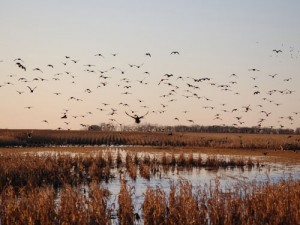The general waterfowl season is underway in the first northern states. With drought conditions persisting in these states, hunting has been slow and crowded in the limited areas with water. Blue winged teal have been moving steadily and quickly down the Central and Mississippi Flyways, pushing through dry states in search of suitable habitat to the south.
Hello folks, and, as always, welcome to Waterfowler.com.
As we begin to celebrate our 15th year of migration tracking and reporting we are starkly reminded of the constant conundrums that exist for waterfowl hunters. This season, the most ducks ever recorded will migrate through the North American flyways. Of course, this absolute boon in waterfowl numbers will be met by the worst habitat conditions that we can remember – so much for having our cake and eating it too.
While increased amounts of precipitation have fallen in drought stricken areas, from North Dakota to Southern Illinois, ponds are dry, lush creeks barely a trickle and countless acres of corn are being mowed or chopped for insurance purposes. Now, before you write of the entire season, there are a few silver linings that can help you salvage your season and provide quality hunting in the face of difficult conditions.
Harsh opening day conditions will likely result in discouraging many fair weather hunters. Crowded conditions around areas with limited water are all ready recording the slowest opening days in many hunting zones within northern states. Expect the herds of weekend warriors to thin quickly – especially during weekdays where many hunters won’t consider the conditions valuable enough to burn a vacation day.
If teal are any indication of the flights of waterfowl to come, the bulk of migrating birds will move quickly and steadily down the flyways. Here today and gone tomorrow scenarios will quickly be replace by the new “here today” group. In short, fresh birds will be a common and regular occurrence and every day of the season will be filled with a new hope.
With limited forage in areas holding water, waterfowl will be forced to search for food in dry areas. Harvested agricultural fields near large holding lakes and refuge areas will provide excellent field hunting opportunity. Hunters that take the time to scout and secure access to these areas will increase their success rate exponentially and reap an unexpected abundance of harvest. Waterfowler.com reminds our field hunting readers that fields that have been mowed or chopped for insurance purposes are considered baited fields by federal definition. Be sure to review your state and federal regulations before hunting in areas near mowed fields to avoid breaking the law.
CANADA:
Hunting is underway in Canada. Conditions and reports from Manitoba and Saskatchewan are good to excellent at this time. Guides are reporting limited open slots for last minute waterfowl hunters. The record numbers of waterfowl are providing outstanding shooting in most areas. If you have ever considered a hunting trip to Canada, this is the year to do it. To book a last minute trip, visit http://manitobawaterfowler.com
PACIFIC FLYWAY:
Duck numbers in Northern California are on the rise with huge concentrations being reported in areas with limited water. Pintail numbers in the Sacramento valley are low for this time of year with teal above average. Duck numbers in the northern portion of the flyway are fair at best for this time of year with goose numbers low.
CENTRAL FLYWAY:
Duck numbers are fair to good in North Dakota with pond counts down at least 50% over previous years. Hunters report increased burning in these dry low areas and many of these marginal wetlands under threat of the plow. Hunting along the Missouri River corridor is expected to be best as birds migrate south during this low water season. Duck numbers are fair to good in South Dakota and Nebraska for the coming opener.
MISSISSIPPI FLYWAY:
Hunter success in Minnesota and Wisconsin ranges from poor to excellent, with duck numbers fair to good in areas with water. Scouting, as always, remains the key to success. Wood duck and teal numbers are good to excellent with ringed neck duck numbers above average for this time of year across the northern portion of the flyway. Mallards and all other are fair. Goose numbers are fair to good in most areas with the first flights of Cackling Canada geese arriving in Wisconsin.
ATLANTIC FLYWAY:
Teal and wood duck numbers are good to excellent through out the New England states. Migrant Canada goose numbers are low for this time of year with resident numbers good to excellent. Teal are present from the Chesapeake Bay to Florida with numbers fair to poor in the lower portion of the flyway.






